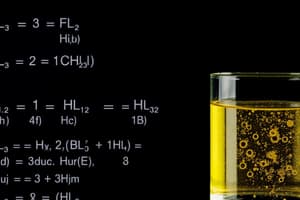Podcast
Questions and Answers
Why does water have a different physical state compared to hydrogen and oxygen?
Why does water have a different physical state compared to hydrogen and oxygen?
- Water has stronger intermolecular forces due to its non-polar nature. (correct)
- Water has weaker intermolecular forces due to its non-polar nature.
- Hydrogen and oxygen are both liquids at room temperature and pressure.
- Hydrogen and oxygen have a polar nature.
What characteristic of hydrogen, oxygen, and water contributes to water not being flammable?
What characteristic of hydrogen, oxygen, and water contributes to water not being flammable?
- The different chemical bonds in water compared to hydrogen and oxygen. (correct)
- The presence of gas in hydrogen and oxygen.
- The production of thermal energy during the reaction.
- The liquid state of water.
What is a sign of a chemical reaction based on the text?
What is a sign of a chemical reaction based on the text?
- Reduction in mass.
- Decrease in pressure.
- Formation of flammable gases.
- Increase in temperature. (correct)
In the Law of Conservation of Matter, what does it mean for matter to be transformed?
In the Law of Conservation of Matter, what does it mean for matter to be transformed?
What does the Law of Conservation of Matter state about the total number of atoms in reactants and products?
What does the Law of Conservation of Matter state about the total number of atoms in reactants and products?
How does electrolysis break substances apart?
How does electrolysis break substances apart?
What does the arrow in a chemical equation symbolize?
What does the arrow in a chemical equation symbolize?
Why is it important to have a balanced chemical equation?
Why is it important to have a balanced chemical equation?
What does putting a coefficient in front of a chemical formula do in an equation?
What does putting a coefficient in front of a chemical formula do in an equation?
What is the purpose of balancing a chemical equation?
What is the purpose of balancing a chemical equation?
What happens if a chemical equation is not balanced?
What happens if a chemical equation is not balanced?
Why do scientists need to balance the number of atoms in a chemical equation?
Why do scientists need to balance the number of atoms in a chemical equation?
Flashcards are hidden until you start studying
Study Notes
Chemical Reactions
- Chemical reactions involve breaking bonds in reactants and forming new bonds to create products.
- Atoms rearrange during a chemical reaction, resulting in changes to both physical and chemical properties.
- New substances with different properties are formed during a chemical reaction.
Inter molecular Forces
- The difference in intermolecular forces between substances determines their physical state.
- Hydrogen and oxygen are gases at room temperature and pressure, but water is a liquid due to stronger intermolecular forces.
Chemical Properties
- Hydrogen and oxygen are flammable gases, but water is not flammable due to different chemical bonds between atoms.
Signs of a Chemical Reaction
- Signs of a chemical reaction include:
- Production of gas
- Production of solid
- Production of light
- Production of thermal energy
Electrolysis
- Electrolysis is a reaction that uses electricity to break down substances into their component parts.
- An electrolysis lab can produce characteristics of oxygen and hydrogen.
Law of Conservation of Matter
- The Law of Conservation of Matter, also known as the Law of Conservation of Mass, states that matter cannot be created or destroyed in a chemical reaction, only transformed.
- This law was first discovered by Antoine Lavoisier in the late 18th century.
- The Law of Conservation of Matter applies to both open and closed systems.
Chemical Equations
- A balanced chemical equation ensures that the same number of atoms of each element are on both sides of the equation.
- To balance an equation, coefficients are used to ensure that the number of atoms of each element is equal on both sides.
- The arrow in a chemical equation symbolizes a change from reactants to products.
Studying That Suits You
Use AI to generate personalized quizzes and flashcards to suit your learning preferences.



